Cirsium
Cirsium is a genus of perennial and biennial flowering plants in the Asteraceae, one of several genera known commonly as thistles. They are more precisely known as plume thistles. These differ from other thistle genera (Carduus, Silybum and Onopordum) in having feathered hairs to their achenes. The other genera have a pappus of simple unbranched hairs.[2]
| Cirsium | |
|---|---|
 | |
| Cirsium vulgare (spear thistle) | |
| Scientific classification | |
| Kingdom: | Plantae |
| Clade: | Tracheophytes |
| Clade: | Angiosperms |
| Clade: | Eudicots |
| Clade: | Asterids |
| Order: | Asterales |
| Family: | Asteraceae |
| Subfamily: | Carduoideae |
| Tribe: | Cardueae |
| Subtribe: | Carduinae |
| Genus: | Cirsium Mill. |
| Synonyms[1] | |
| |
They are mostly native to Eurasia and northern Africa, with about 60[3] species from North America (although several species have been introduced outside their native ranges).
Thistles are known for their effusive flower heads, usually purple, rose or pink, also yellow or white. The radially symmetrical disc flowers are at the end of the branches and are visited by many kinds of insects, featuring a generalised pollination syndrome.[4] They have erect stems and prickly leaves, with a characteristic enlarged base of the flower which is commonly spiny. The leaves are alternate, and some species can be slightly hairy. Extensions from the leaf base down the stem, called wings, can be lacking (Cirsium arvense), conspicuous (Cirsium vulgare), or inconspicuous. They can spread by seed, and also by rhizomes below the surface (Cirsium arvense). The seed has tufts of tiny hair, or pappus, which can carry them far by wind.
Cirsium thistles are used as food plants by the larvae of some Lepidoptera species—see list of Lepidoptera that feed on Cirsium. The seeds are attractive to small finches such as American goldfinch.
Most species are considered weeds, typically by agricultural interests. Cirsium vulgare (bull thistle, common thistle, or spear thistle) is listed as a noxious weed in nine US states.[5] Some species in particular are cultivated in gardens and wildflower plantings for their aesthetic value and/or to support pollinators such as butterflies. Some species dubbed weeds by various interest groups can also provide these benefits. Cirsium vulgare, for instance, ranked in the top 10 for nectar production in a UK plants survey conducted by the AgriLand project which is supported by the UK Insect Pollinators Initiative. Cirsium vulgare was also a top producer of nectar sugar in another study in Britain, ranked third with a production per floral unit of (2323 ± 418μg).[6] Not only does it provide abundant nectar, it provides seeds for birds, such as the American goldfinch, Spinus tristis, and supports the larvae of a Painted Lady butterfly, Vanessa cardui.[7] Some other common species are: Cirsium arvense, Cirsium palustre, Cirsium oleraceum.
Some ecological organizations, such as the Xerces Society, have attempted to raise awareness of the benefits of thistles, to counteract the general agricultural and home garden labeling of thistles as unwanted weeds. The monarch butterfly (Danaus plexippus), for instance, was highlighted as relying upon thistles such as Tall thistle (Cirsium altissimum) as nectar sources during its migration.[8] Some prairie and wildflower seed production companies supply bulk seed for native North American thistle species, for wildlife habitat restoration, although availability tends to be low. Thistles are particularly valued by bumblebees for their high nectar production.
Certain species of Cirsium, like Cirsium monspessulanum, Cirsium pyrenaicum and Cirsium vulgare, have been traditionally used as food in rural areas of southern Europe. Cirsium oleraceum is cultivated as a food source in Japan and India. Cirsium setidens is used as a vegetable in Korean cuisine.
'Cirsium' is the Greek word for thistle, kirsos, likely derived from 'swollen vein'. The flower blooms April to August.
Selected species
- Cirsium acarna – soldier thistle
- Cirsium acaule – stemless thistle, dwarf thistle
- Cirsium altissimum – roadside thistle, tall thistle
- Cirsium amblylepis – Mt. Tamalpais thistle
- Cirsium andersonii – Anderson's thistle, rose thistle
- Cirsium andrewsii – Franciscan thistle
- Cirsium arizonicum – Arizona thistle
- Cirsium arvense – creeping thistle, field thistle, Canada thistle
- Cirsium arvense var.argenteum
- Cirsium arvense var. integrifolium
- Cirsium arvense var. mite
- Cirsium arvense var. vestitum
- Cirsium barnebyi – Barneby's thistle
- Cirsium brachycephalum
- Cirsium brevifolium – Palouse thistle
- Cirsium brevistylum – clustered thistle
- Cirsium calcareum – Cainville thistle
- Cirsium californicum – California thistle
- Cirsium callilepis – fringebract thistle
- Cirsium campylon – Mount Hamilton thistle
- Cirsium canescens – Platte thistle, prairie thistle
- Cirsium canovirens – graygreen thistle
- Cirsium canum – Queen Anne's thistle
- Cirsium carolinianum – Carolina thistle, soft thistle
- Cirsium caulescens
- Cirsium centaureae
- Cirsium chellyense – queen thistle
- Cirsium chuskaense – monarch thistle
- Cirsium ciliolatum – ashland thistle
- Cirsium clavatum – lake thistle
- Cirsium clokeyi – Charleston Mountain thistle, whitespine thistle
- Cirsium congdonii – rosette thistle
- Cirsium costaricense
- Cirsium coulteri – Coulter's thistle
- Cirsium crassicaule – slough thistle
- Cirsium cymosum – peregrine thistle
- Cirsium diacanthum
- Cirsium discolor – field thistle, pasture thistle
- Cirsium dissectum – meadow thistle
- Cirsium douglasii
- Cirsium drummondii – dwarf thistle
- Cirsium durangense
- Cirsium eatonii – Eaton's thistle
- Cirsium edule – edible thistle
- Cirsium engelmannii – Engelmann thistle, Engelmann's thistle
- Cirsium eriophorum – woolly thistle
- Cirsium erisithales – yellow melancholy thistle
- Cirsium esculentum
- Cirsium flodmanii – Flodman thistle, Flodman's thistle
- Cirsium foliosum – Drummond's thistle, elk thistle, leafy thistle, meadow thistle
- Cirsium fontinale – fountain thistle
- Cirsium funkiae – funky thistle
- Cirsium gilense – Gila thistle
- Cirsium grahamii – Graham's thistle
- Cirsium griseum – gray thistle
- Cirsium hallii – Hall's thistle
- Cirsium helenioides – melancholy thistle, common melancholy thistle
- Cirsium heterophyllum – melancholy thistle
- Cirsium hillii – Hill's thistle
- Cirsium hookerianum – white thistle
- Cirsium horridulum – yellow thistle
- Cirsium humboldtense – Humboldt County thistle
- Cirsium hydrophilum – Suisun thistle
- Cirsium hypoleucum
- Cirsium inornatum – Cloudcroft thistle
- Cirsium jaliscoense – G.L.Nesom
- Cirsium japonicum – Japanese thistle
- Cirsium kamtschaticum – Kamchatka thistle
- Cirsium kawakamii – Yushan thistle
- Cirsium lanatum – hairy thistle
- Cirsium lanceolatum
- Cirsium laterifolium – porcupine thistle
- Cirsium lecontei – Le Conte's thistle
- Cirsium leo
- Cirsium libanoticum
- Cirsium loncholepis – LaGraciosa thistle
- Cirsium longistylum – longstyle thistle
- Cirsium maritimum
- Cirsium mendocinum – Mendocino thistle
- Cirsium mexicanum – Mexican thistle
- Cirsium modestum – lacy thistle
- Cirsium mohavense – Mojave thistle
- Cirsium murdockii – Murdock's thistle
- Cirsium muticum – swamp thistle
- Cirsium navajoense – Navajo thistle
- Cirsium neomexicanum – lavender thistle, New Mexico thistle, powderpuff thistle
- Cirsium nipponicum
- Cirsium nuttallii – Nuttall's thistle
- Cirsium occidentale – cobweb thistle
- Cirsium ochrocentrum – yellowspine thistle
- Cirsium oleraceum – cabbage thistle
- Cirsium olivescens – summer thistle
- Cirsium oreophilum – crow thistle
- Cirsium osterhoutii – Osterhout's thistle
- Cirsium ownbeyi – Ownbey's thistle
- Cirsium pallidum – pale thistle
- Cirsium palustre – marsh thistle, European swamp thistle
- Cirsium parryi – Parry's thistle
- Cirsium pastoris – snowy thistle
- Cirsium peckii – Steens Mountain thistle
- Cirsium pendulum
- Cirsium perplexans – Rocky Mountain thistle
- Cirsium pitcheri – Pitcher's thistle, sand dune thistle
- Cirsium praeteriens – Palo Alto thistle, lost thistle
- Cirsium proteanum – red thistle
- Cirsium pulcherrimum – Wyoming thistle
- Cirsium pumilum – pasture thistle
- Cirsium pyrenaicum
- Cirsium quercetorum – Alameda County thistle
- Cirsium remotifolium – fewleaf thistle
- Cirsium remotifolium var. remotifolium – fewleaf thistle
- Cirsium repandum – sandhill thistle
- Cirsium rhaphilepis
- Cirsium rhinoceros – Korean prickly thistle[9]
- Cirsium rhothophilum – surf thistle
- Cirsium rivulare
- Cirsium rothrockii – Rothrock's thistle
- Cirsium rusbyi – Rusby's thistle
- Cirsium rydbergii – Rydberg's thistle
- Cirsium scabrum – rough thistle
- Cirsium scapanolepis – mountain slope thistle
- Cirsium scariosum – meadow thistle
- Cirsium scopulorum – mountain thistle
- Cirsium segetum
- Cirsium serrulatum
- Cirsium setidens – gondre or Korean thistle
- Cirsium spinosissimum
- Cirsium subniveum – gray thistle, Jackson Hole thistle
- Cirsium tanakae
- Cirsium texanum – Texas thistle
- Cirsium tioganum – stemless thistle
- Cirsium tuberosum – tuberous thistle – similar to Cirsium dissectum (meadow thistle)
- Cirsium turneri – cliff thistle
- Cirsium undulatum – gray thistle, wavy-leaf thistle, wavyleaf thistle
- Cirsium undulatum var. tracyi – Tracy's thistle, wavyleaf thistle
- Cirsium undulatum var. undulatum – wavyleaf thistle
- Cirsium validus – graceful thistle
- Cirsium vernale – spring thistle
- Cirsium vinaceum – Sacramento Mountain thistle, Sacramento Mountains thistle
- Cirsium virginense – virgin thistle
- Cirsium virginianum – Virginia thistle
- Cirsium vulgare – bull thistle, spear thistle, common thistle, Fuller's thistle (syn. C. lanceolatum)
- Cirsium wheeleri – Wheeler's thistle
- Cirsium wrightii – Wright's thistle
- Hybrids
- Cirsium × canalense – canal thistle
- Cirsium × crassum – thistle
- Cirsium × erosum – glory thistle
- Cirsium × iowense – Iowa thistle
- Cirsium × vancouverense – Vancouver thistle
Image gallery
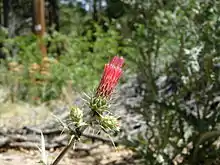 Cirsium arizonicum (Arizona thistle)
Cirsium arizonicum (Arizona thistle)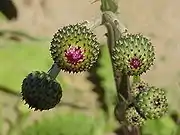 Cirsium canum (Queen Anne's thistle)
Cirsium canum (Queen Anne's thistle)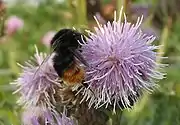 Bumblebee on thistle flowerhead (Cirsium arvense)
Bumblebee on thistle flowerhead (Cirsium arvense)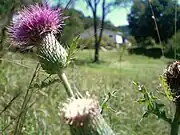 Cirsium vulgare (bull thistle, common thistle, or spear thistle)
Cirsium vulgare (bull thistle, common thistle, or spear thistle)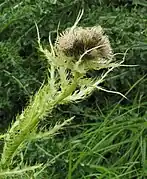 Spiniest thistle (Cirsium spinosissimum)
Spiniest thistle (Cirsium spinosissimum)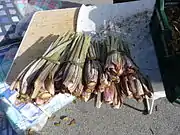 Cirsium pyrenaicum cut and ready to cook
Cirsium pyrenaicum cut and ready to cook Texas purple thistle
Texas purple thistle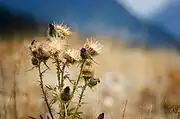 Dried Cirsium in Canadian autumn
Dried Cirsium in Canadian autumn
References
- Flann, C (ed) 2009+ Global Compositae Checklist Archived 2014-11-14 at archive.today
- Rose, Francis (1981). The Wild Flower Key. Frederick Warne & Co. pp. 377–380. ISBN 0-7232-2419-6.
- "Cirsium". Flora of North America.
- Van Der Kooi, C. J.; Pen, I.; Staal, M.; Stavenga, D. G.; Elzenga, J. T. M. (2015). "Competition for pollinators and intra-communal spectral dissimilarity of flowers". Plant Biology. 18 (1): 56–62. doi:10.1111/plb.12328. PMID 25754608.
- "PLANTS Profile for Cirsium vulgare (bull thistle) USDA PLANTS". USDA Plant Database. USDA. Retrieved 2008-07-15.
- Hicks, DM; Ouvrard, P; Baldock, KCR (2016). "Food for Pollinators: Quantifying the Nectar and Pollen Resources of Urban Flower Meadows". PLOS ONE. 11 (6): e0158117. Bibcode:2016PLoSO..1158117H. doi:10.1371/journal.pone.0158117. PMC 4920406. PMID 27341588.
- "Which flowers are the best source of nectar?". Conservation Grade. 2014-10-15. Archived from the original on 2019-12-14. Retrieved 2017-10-18.
- Eckberg, James; Lee-Mäder, Eric; Hopwood, Jennifer; Foltz Jordan, Sarah; Borders, Brianna (2017). "Native Thistles: A Conservation Practitioner's Guide". The Xerces Society. The Xerces Society. Retrieved 27 August 2018.
- English Names for Korean Native Plants (PDF). Pocheon: Korea National Arboretum. 2015. p. 412. ISBN 978-89-97450-98-5. Archived from the original (PDF) on 25 May 2017. Retrieved 22 December 2016 – via Korea Forest Service.
Further reading
- Everitt, J.H.; Lonard, R.L.; Little, C.R. (2007). Weeds in South Texas and Northern Mexico. Lubbock: Texas Tech University Press. ISBN 0-89672-614-2
 Media related to Cirsium at Wikimedia Commons
Media related to Cirsium at Wikimedia Commons